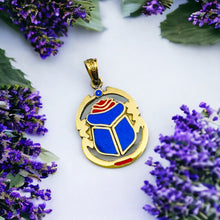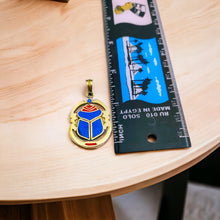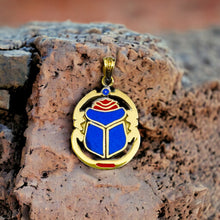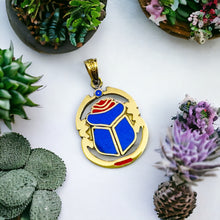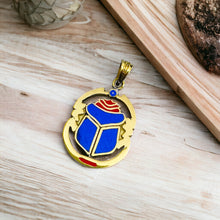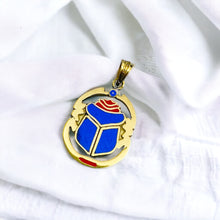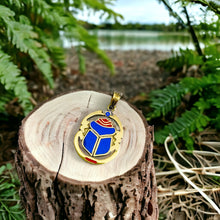
The Gold Royal Scarab Pendant Necklace: Inspired by ancient Egyptian culture, this exquisite piece melds modern luxury with historical allure. Crafted in gleaming gold, it pays homage to the sacred scarab beetle, symbolizing eternal life and rebirth, dating back to the pharaohs' reign. A timeless emblem of power and beauty, this necklace brings centuries of history into contemporary elegance.
- History: Ancient Egypt revered the scarab beetle for its symbolism of regeneration and protection.
- Spiritually: Scarabs were seen as symbols of immortality, resurrection, transformation, and protection in ancient Egyptian spirituality.
- Talisman: The scarab was often used as a talisman for good luck and protection against evil forces.
- Handmade: Crafted meticulously by skilled artisans, each pendant is a unique piece of art.
- Healing: Believed to bring healing energies and protection to the wearer.
- Material Gold: Made from pure gold, symbolizing wealth, luxury, and eternity.
- Symbolism: The scarab represents the cycle of life, the sun, and transformation.
- How to Wear: Suspended on a delicate gold chain, it can be worn close to the heart for maximum spiritual benefit.
- Gold Royal Scarab Pendant Necklace: A timeless piece of jewelry that embodies ancient wisdom and modern elegance.
History Side For Those Who Are Interested
The Egyptian Royal Scarab Amulet holds a significant place in the cultural and religious heritage of ancient Egypt, dating back to the predynastic period (c. 5500–3100 BCE) and enduring throughout various dynasties until the Greco-Roman period. This emblematic artifact, shaped in the form of a dung beetle (Scarabaeus sacer), symbolized various aspects of Egyptian cosmology, spirituality, and the monarchy.
The scarab beetle, commonly found rolling balls of dung in the Egyptian desert, became associated with the sun god Ra due to its habit of rolling dung balls as the sun rolls across the sky. This association led to the scarab being revered as a symbol of transformation, renewal, and protection. As such, it was incorporated into numerous aspects of Egyptian life, including jewelry, amulets, seals, and funerary artifacts.
The use of scarab amulets as protective charms and symbols of regeneration became widespread during the Middle Kingdom (c. 2055–1650 BCE), reaching its zenith in the New Kingdom (c. 1550–1070 BCE). Scarabs were fashioned from various materials, including faience, precious metals like gold and silver, and semiprecious stones such as lapis lazuli and carnelian. These amulets were inscribed with spells, prayers, or the names of pharaohs, intended to imbue the wearer with divine protection, guidance, and power.
During the reign of certain pharaohs, notably Amenhotep III (c. 1386–1353 BCE) and Tutankhamun (c. 1332–1323 BCE), the scarab amulet attained particular prominence as a symbol of royal authority and divine favor. Amenhotep III, in particular, commissioned numerous scarabs bearing his name and titles, distributing them as diplomatic gifts and tokens of his reign's prosperity. Tutankhamun's tomb, famously discovered by Howard Carter in 1922, contained several scarab amulets, underscoring their enduring significance in funerary rituals and beliefs surrounding the afterlife.
Beyond their religious and symbolic importance, scarab amulets also served practical functions. They were often used as seals, impressed onto clay or wax to authenticate documents and goods. Additionally, they were believed to possess apotropaic qualities, warding off evil spirits, illness, and misfortune.
The legacy of the Egyptian Royal Scarab Amulet extends far beyond the borders of ancient Egypt, influencing later cultures and enduring in the popular imagination to this day. Its enduring symbolism of transformation, protection, and divine authority continues to captivate scholars and enthusiasts, offering a glimpse into the rich tapestry of Egyptian civilization and its intricate belief systems.










